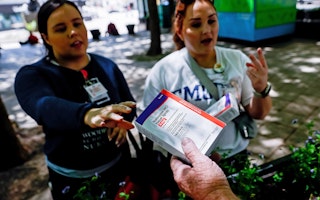Five Ways Drug Policy Reform Accelerated This Year
By Patrick Gallahue
The starting pistol was fired in 2012—with calls for reform from Latin America and marijuana regulation in two U.S. states—but 2013 sent drug policy reform into a full sprint. The once ambiguous calls for change are beginning to take shape as legislative proposals, and the United Nations began preparations for a global summit on drugs in 2016.
There is still a lot of work to do. Mass incarceration for minor offenses remains epidemic, repressive governments refuse to introduce life-saving services, and violence associated with illicit markets persists around the world. Nevertheless, this year saw drug policy reform accelerate at a breakneck pace, and advocates can be as optimistic as ever that the status quo will not stand.
Here are five game-changers that occurred in 2013 that could mark the beginning of the end of the war on drugs.
1. Seeds of Global Marijuana Reform in the U.S. and Uruguay
What a note on which to end the year! Around 13 months after the voters in Colorado and Washington legalized marijuana, Uruguay became the first national government in the world to officially regulate the supply and sale of marijuana.
The country’s new law represents a trend that is gaining unstoppable momentum. In the US, there is more public support for marijuana law reform than ever and in other countries, local jurisdictions are also pioneering alternative policies. These include decriminalization of minor offenses and non-profit cannabis clubs, such as those operating in Catalonia, Spain. Cannabis clubs are now being discussed in the cities of Copenhagen, Utrecht, Geneva and Mexico City.
2. Trust But Verify: The U.S. Department of Justice Weighs In
While the voters of Washington and Colorado made their voices heard, the new policy remained somewhat tentative insofar as it was at odds with U.S. federal law. Until recently it was unclear whether federal law enforcement would crack down on marijuana production and sale in the two states.
But the Federal Department of Justice announced in September that it would allow these regulations to go into effect. The government will monitor Washington and Colorado, but will not interfere as long as key federal priorities are respected. Those priorities include assurance that marijuana is not distributed to minors; it is not diverted to states where it is illegal; and that revenues do not benefit criminal enterprises, gangs, and cartels.
3. New Approach to Synthetic Drugs in New Zealand
New psychotropic substances, sometimes called "legal highs," continue to be one of the greatest challenges to lawmakers in Europe and the United States. These synthetic drugs, which mimic the effects of illicit drugs, are untested, potentially dangerous, and difficult for lawmakers to keep track of. As soon as they're banned, a chemist—amateur or professional—only has to develop a new chemical cocktail that produces highs similar to drugs banned by national or international law.
New Zealand introduced an innovative means of dealing with new psychotropic substances. The government has officially regulated the "legal highs" market by creating a pathway for them to be legally manufactured and sold. However, the law requires any new substances to go through a lengthy testing process before they can be approved for legal sale.
Potential manufacturers of new psychoactive substances will have to submit to roughly NZ$180,000 (around US$149,000) in application fees plus an additional NZ$1 million to NZ$2 million (US$800,000 to US$1.6 million) in costs to test each product they want to sell. Should producers bypass the law, they will be subject to strict penalties, including up to eight years in prison and very heavy fines.
One principal criticism, however, is that the system creates a pathway to legalize synthetic drugs while potentially less harmful organic ones remain prohibited. Nevertheless, the New Zealand approach is a pioneering model to be watched.
4. A New Path for Drug Policy in the Americas
While local and national efforts made most news in 2013, a usually press-shy multilateral organization also made a splash. In May, the Secretary-General of the Organization of American States launched a monumental report on drug control that considers alternatives to current policies internationally. It was notably the first time any major multilateral agency had given a serious and detailed visualization to alternatives to prohibition, including legal market regulation or reform of UN drug conventions.
The review, commissioned at 2012’s Summit of the Americas held in Cartagena, reflects growing dissatisfaction with the status quo. Several Latin American heads of state, frustrated with the failure and indeed counterproductive nature of existing drug control structures, pushed for this review.
The report envisioned possibilities for the future of drug policy between now and 2025, many which would have been unthinkable just a few years ago.
5. The Drug Debate Heads to the United Nations
The UN’s long-awaited world summit on global drug policy is still a couple of years away (2016) but cracks in the long-held consensus backing the current system are already appearing.
Governments are increasingly voicing their dissatisfaction with failed criminal justice-oriented approaches and calling for health services, alternatives to incarceration for minor drug offenses, and an exploration of models that will reduce violence and insecurity.
Until February 2015, Patrick Gallahue was a communications officer with the Global Drug Policy Program.


